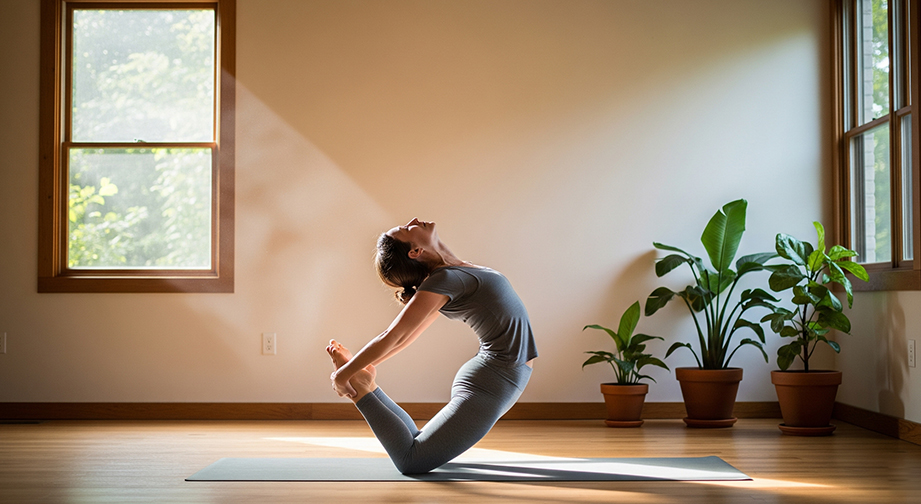Kapotasana (Pigeon Pose – Kneeling): Complete Guide for All Levels
Introduction
Kapotasana — also known as the Pigeon Pose (Kneeling) — is a deep, heart-opening yoga asana that stretches your hips, thighs, and back. In Sanskrit, “Kapota” means “pigeon," symbolizing lightness and transformation. At its core, this posture is all about balancing and releasing tension, both physically and mentally.
If you’ve ever felt stiff after sitting for long hours or experienced sore hips, Kapotasana could be your best friend! This beginner-friendly pose meets your body where it is, making it a wonderful tool for anyone seeking more flexibility, relaxation, and peace of mind.
Step-by-Step Guide to Kapotasana (Kneeling Pigeon Pose)

- Begin in a kneeling position, sitting upright on your shins with knees hip-width apart.
- Inhale: Place your hands on your hips, gently draw your tailbone down, and lift your chest.
- Exhale: Lean back slightly, and carefully bring your hands down to rest on your heels or the floor beside your feet (use blocks next to ankles if needed).
- Inhale: Lengthen your spine, lift through the sternum, and keep your shoulders relaxed.
- Exhale: Press your hips forward, keep your thighs perpendicular to the floor, and open the front body.
- Stay for 3–5 breaths if you’re new, gradually increasing up to 5–8 breaths as you become more comfortable. Repeat 1–2 rounds as needed.
- To exit: Inhale, engage your core, and gently come back upright, releasing your hands from your heels.
- Modifications for Beginners: Place yoga blocks under your hands or a folded blanket under your knees for extra cushioning.
- To Intensify: Carefully drop your head backward, or deepen the backbend by reaching farther down your feet or even towards the floor (only if safe and stable).
Alignment & Safety Tips
- Alignment: Keep your thighs vertical; avoid letting your hips sink backward. Draw your lower ribs in and keep the neck long.
- Common Mistakes: Collapsing the lower back, forcing the head back, or letting knees splay out too wide.
- Safety: Avoid if you have severe knee, back, or neck injuries, or if you’re pregnant. Always listen to your body’s signals and ease out if there’s pinching pain.
Benefits of Kapotasana
Physical Benefits
- Stretches hip flexors, quadriceps, and chest
- Improves spinal flexibility and posture
- Strengthens back muscles and opens shoulders
- May help relieve lower back stiffness
Mental Benefits
- Reduces stress and anxiety
- Promotes a sense of spaciousness and release
- Encourages deep, mindful breathing
Energy / Chakra Connection
- Stimulates the Heart Chakra (Anahata), encouraging emotional openness
- Activates the Solar Plexus Chakra (Manipura), boosting confidence
Contraindications
- If you have knee, ankle, or lower back injuries—avoid this pose
- Pregnancy
- Spinal or neck issues — consult with a healthcare professional
Safe Alternatives:
- Sphinx Pose
- Bridge Pose (Setu Bandhasana)
- Supported Reclined Bound Angle Pose
Beginner’s Tips & Variations
- Props: Use blocks under hands, bolster under hips, or strap around ankles for support.
- Gentle Variation: Stay upright and skip the backbend, focus on lifting through the spine.
- Advanced Variation: Deepen the backbend, eventually lowering forearms to the floor or bringing hands to toes.
How to Include Kapotasana in a Yoga Flow
- Best as a main practice or deep heart-opener near the end of a session.
- Pairs well with: Camel Pose (Ustrasana), Downward Dog (Adho Mukha Svanasana), and Seated Forward Fold (Paschimottanasana).
Mind-Body Connection
Practice Kapotasana with an attitude of loving awareness. Notice the gentle rise and fall of your breath. This pose invites you to release old emotions and create space in both body and heart, making it a powerful heart-chakra opener for emotional healing.
Summary Box:
Asana Name: Kapotasana (Kneeling Pigeon Pose)
Level: Intermediate (with safe modifications for beginners)
Focus Areas: Hips, back, chest, quadriceps
Duration: 3–8 breaths per round
Best Time to Practice: Morning or Evening
Kapotasana (Pigeon Pose – Kneeling): FAQs
Q: Is Kapotasana suitable for beginners?
A: Yes, with props and modifications, beginners can safely practice a gentle version and gradually deepen over time.
Q: How often should I practice Kapotasana?
A: 2–3 times per week is a great start. Always listen to your body.
Q: What if I feel pain in my knees or back?
A: Immediately stop and try an alternative pose, or consult a certified yoga instructor or healthcare provider.
Remember: Yoga is a journey, not a competition. Be gentle with yourself as you explore Kapotasana. With patience and mindful practice, you’ll experience the many gifts this beautiful asana has to offer.